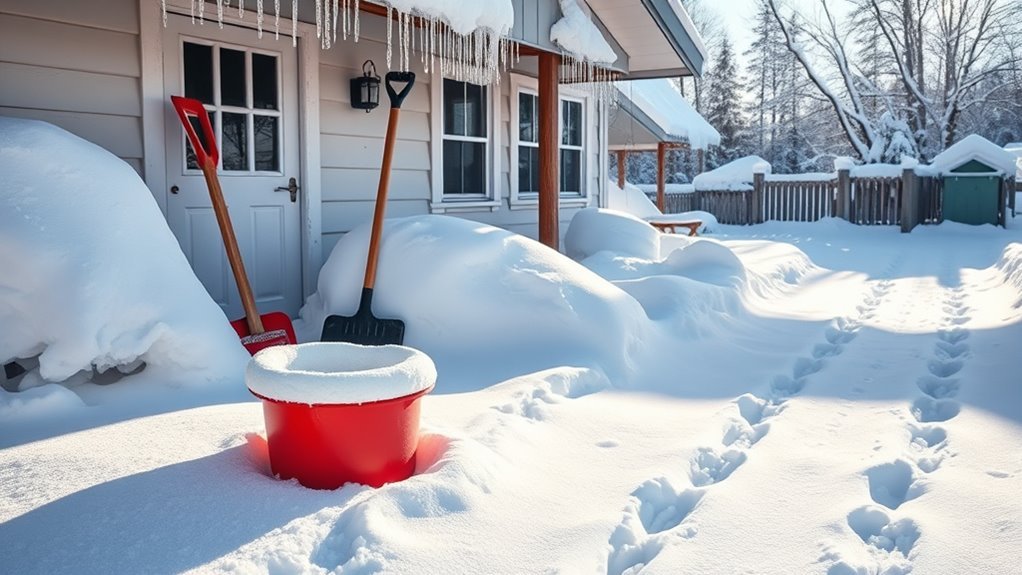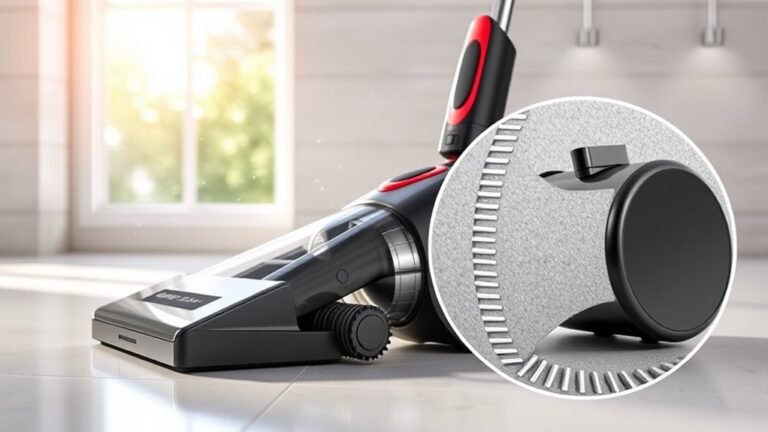How to Clean Your Home After a Snowstorm
After a snowstorm, start by gathering gloves, a shovel, absorbent mats, and eco-friendly cleaners. Clear snow and ice from entryways carefully to prevent slips. Quickly dry wet floors and carpets using towels and fans to avoid mold. Knock off and clean muddy boots outside to stop indoor messes. Improve ventilation and use dehumidifiers to tackle moisture damage. Taking these steps now can save you headaches later—there’s more to uncover for keeping your home winter-ready.
Preparing Your Cleaning Supplies and Equipment

Before you begin cleaning up after a snowstorm, gather all the essential supplies and equipment you’ll need. Freedom means being prepared, so create a cleaning checklist to keep you focused and efficient. Start with basics like sturdy gloves, snow shovels, and a broom to tackle indoor debris. Don’t forget absorbent mats and a mop to handle wet floors safely. Have salt or ice melt ready for any slippery spots inside. Choose eco-friendly cleaning solutions to maintain your space without compromising your values. By assembling your essential supplies beforehand, you’re in control, ready to restore your home quickly and confidently. This preparation isn’t just about cleaning—it’s about reclaiming your space and your freedom after the storm.
Removing Snow and Ice From Entryways
Although removing snow and ice from your entryways can be tough work, it’s essential for safety and preventing damage. Start with effective snow shoveling tips: use a sturdy, ergonomic shovel and push snow rather than lifting to save energy. Clear a path wide enough for easy access, focusing on steps and thresholds. For ice removal techniques, apply rock salt or eco-friendly ice melt to prevent slippery surfaces. Avoid using sharp tools that can damage your flooring or concrete. Remember to work steadily, taking breaks if needed, to maintain your freedom to move safely in and out of your home. Tackling this task efficiently lets you regain control and enjoy a safer, more accessible entryway after the storm.
Drying and Cleaning Wet Floors and Carpets

Once the snow and ice are cleared, you’ll need to tackle any wet floors and carpets to prevent damage and mold growth. Quick action is key since carpet absorption can trap moisture deep within fibers. Start by blotting excess water with towels or a wet/dry vacuum. Next, focus on efficient floor drying to avoid lingering dampness. Here’s how you can manage it effectively:
Act swiftly to dry wet floors and carpets, preventing damage and mold growth after snow and ice removal.
- Open windows and doors to boost airflow and speed up drying.
- Use fans or dehumidifiers strategically to pull moisture out of carpets and floors.
- Remove rugs and cushions, allowing all surfaces to air out completely.
Dealing With Muddy Boots and Outerwear
When you come inside with muddy boots and wet outerwear, it’s important to tackle the mess quickly to prevent stains and damage. You’ll want to know the best ways to remove mud, dry your clothes properly, and clean your boots thoroughly. Let’s go over some simple techniques to keep your gear in great shape after a snowstorm.
Mud Removal Techniques
Before you track mud further into your home, it’s important to tackle muddy boots and outerwear right away. Mud removal techniques help keep your space clean and free, letting you enjoy your home without extra mess. Start by knocking off excess mud outside or on a durable outdoor matting solution; this prevents dirt from spreading indoors. Then, follow these simple steps:
- Use a stiff brush to loosen dried mud from boots and jacket surfaces.
- Rinse items with lukewarm water, avoiding harsh scrubbing that can damage fabrics.
- Apply mud prevention tips like treating footwear with waterproof sprays to reduce future buildup.
Outerwear Drying Tips
Although mud removal is essential, properly drying your boots and outerwear prevents lingering dampness and odors that can damage materials. After cleaning, use sturdy drying racks to air out your gear, ensuring airflow reaches all outerwear materials. Avoid direct heat, which can warp or weaken fabrics.
| Item | Best Drying Method | Tips for Longevity |
|---|---|---|
| Boots | Remove insoles, air dry | Use boot shapers for form |
| Waterproof Jackets | Hang on drying racks | Avoid wringing or direct sun |
| Wool Hats | Lay flat on rack | Reshape while damp |
| Gloves | Air dry, avoid heat | Stuff with paper towels to retain shape |
Drying right means freedom to enjoy every snow day without worries.
Boot Cleaning Essentials
Keeping your boots clean after a snowstorm is just as important as drying them properly. Mud and salt can damage your boots if left untreated, so it’s key to act quickly. Here are some essential boot maintenance tips to keep your footwear in top shape while enjoying your freedom outdoors:
- Wipe off mud and salt immediately using a damp cloth or soft brush.
- Use a specialized cleaner suited for your boot material to remove stubborn stains.
- Apply a waterproofing spray once dry to protect against future moisture.
Once clean, consider smart boot storage solutions like breathable racks or ventilated boxes to prevent mold and maintain shape. By following these steps, you’ll extend your boots’ life and stay ready to embrace any snowy adventure that comes your way.
Preventing Mold and Moisture Damage
After a snowstorm, you’ll want to dry any wet areas quickly to stop mold from taking hold. Make sure your home has good ventilation to keep moisture levels down. These steps are key to protecting your space from water damage.
Dry Wet Areas Promptly
Since snowmelt and tracked-in moisture can quickly soak your floors and carpets, you’ll want to dry wet areas as soon as possible. Prompt moisture management is key to wet area prevention and stopping mold before it starts. Don’t let damp spots linger—they become breeding grounds for mold and damage your freedom to enjoy a clean space.
Here’s how to tackle it efficiently:
- Use absorbent towels or a wet/dry vacuum to remove as much water as possible.
- Place fans or portable heaters nearby to accelerate drying.
- Check hidden spots like under rugs or furniture to verify no moisture remains.
Improve Indoor Ventilation
A well-ventilated home helps prevent mold growth and moisture damage by circulating fresh air and reducing humidity. After a snowstorm, it’s essential you boost air circulation to keep your indoor environment dry and healthy. Open windows whenever possible to let fresh air flow freely, even if it’s just for a short time. Use exhaust fans in kitchens and bathrooms to pull out excess moisture. If you have a whole-house ventilation system, make sure it’s running efficiently. This simple step lets you reclaim control over your space, preventing the stuffiness and dampness that invite mold. By prioritizing fresh air and proper air circulation, you’re protecting your home and creating a breathable, comfortable sanctuary free from moisture problems.
Restoring Outdoor Areas and Walkways

When the snow starts to melt, you’ll want to clear debris and ice from your outdoor areas and walkways to prevent slips and damage. Taking care of your outdoor furniture and driveway maintenance now lets you enjoy your space freely without worry. Start by removing any leftover salt or sand that can wear down surfaces. Then, inspect your driveway for cracks or potholes that might need quick repairs. Finally, give your outdoor furniture a thorough cleaning to keep it ready for sunny days.
- Sweep and hose down walkways to remove dirt and ice melt residues
- Use eco-friendly deicers to protect surfaces and plants
- Check and tighten any loose screws or bolts on outdoor furniture
This routine keeps your outdoor space safe, functional, and inviting for your next adventure.
Häufig gestellte Fragen
How Soon After a Snowstorm Should I Start Cleaning My Home?
You should start snow removal as soon as it’s safe to do so, so your cleaning schedule stays on track without feeling rushed. Waiting too long can make the job harder and messier inside your home. Once the snow’s cleared from walkways and entry points, you’re free to focus on tidying up indoors. Staying proactive means less stress and more freedom to enjoy your space after the storm passes.
What Are the Best Eco-Friendly Cleaning Products for Post-Snowstorm Messes?
When tackling post-snowstorm messes, you’ll want natural cleaners that’re tough yet gentle on your space and the planet. Biodegradable options like vinegar, baking soda, and castile soap are fantastic—they break down easily and won’t harm the environment. You can mix them up yourself or choose eco-friendly brands that prioritize sustainable ingredients. This way, you keep your home fresh and your conscience clear, giving you the freedom to enjoy a clean, green space.
Can Pets Track in Snow and Mud, and How Should I Clean It?
You might think it’s a hassle to clean snowy paws every time your pet comes inside, but it’s way easier than dealing with muddy floors later. When your furry friend tracks snow and mud in, grab a microfiber towel or pet-safe wipes to gently clean their paws at the door. This quick step keeps your floors cleaner and gives you more freedom to enjoy your space without constant mopping.
How Do I Safely Unplug and Store Snow-Melting Equipment?
When unplugging snow-melting equipment, you’ll want to prioritize snow melt safety by ensuring the device is completely off and cooled down first. Don’t yank the cord; gently unplug it by the plug itself. For equipment storage, coil cords loosely to avoid damage and store everything in a dry, sheltered place to prevent rust or electrical issues. Taking these simple steps lets you enjoy freedom from worries next winter.
What Are Signs of Hidden Water Damage After a Snowstorm?
You’ll want to watch for signs of hidden leaks like musty odors, warped walls, or peeling paint—they’re clues moisture detection tools can confirm. If you spot water stains or feel damp spots on floors or ceilings, don’t ignore them. Mold growth or unusually high humidity indoors also signals trouble. By catching these early, you’re free to tackle issues before they become costly, keeping your home safe and sound.






